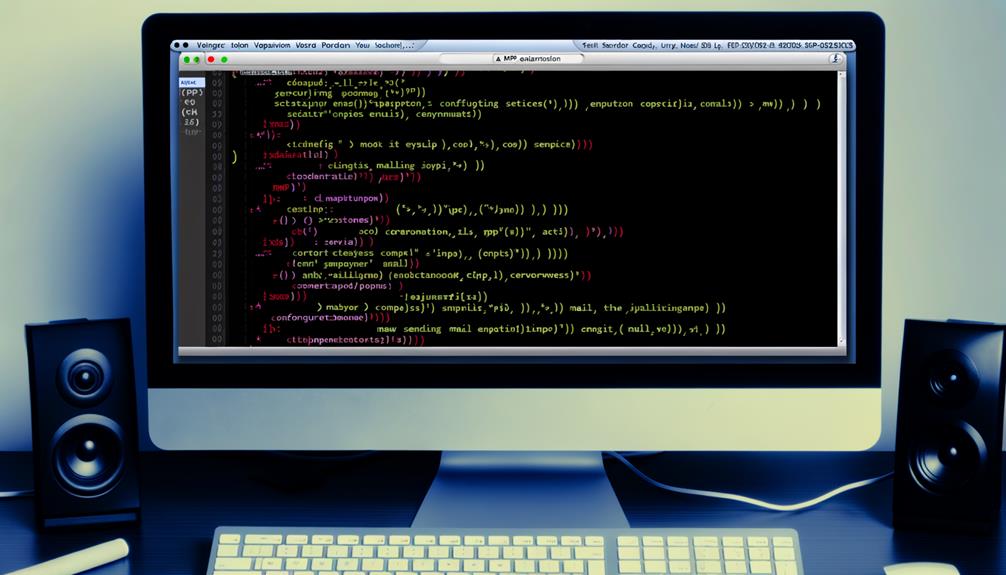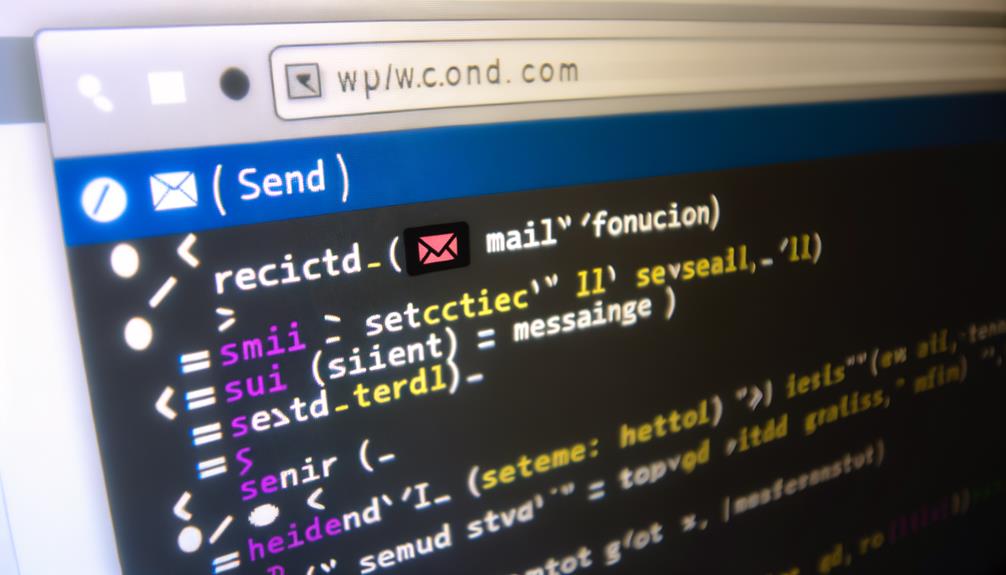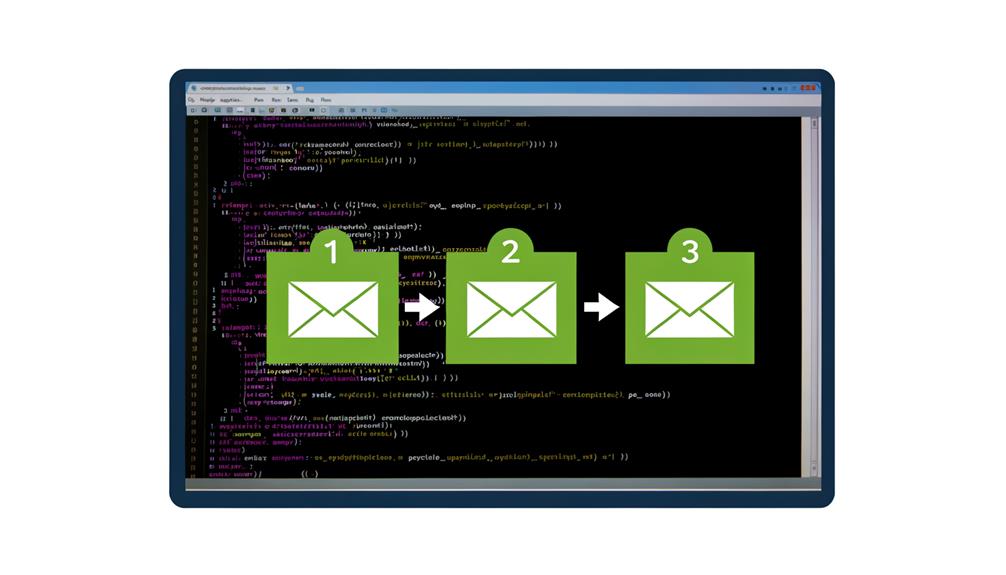When it comes to sending emails in PHP, it's like unlocking a door to seamless communication with your users or customers. Mastering this process can significantly impact your web development efforts.
So, how do we seamlessly integrate this functionality into our PHP environment? Well, we've broken it down into three straightforward steps that will have you sending emails with ease.
But hold on, there's more to it than just hitting send. Let's walk through the process together and ensure your emails reach their intended recipients effectively and in compliance with email standards.
Configuring PHP Environment for Email Sending

When setting up the PHP environment for sending emails, it's imperative to ensure that the PHP.ini file includes defined SMTP server settings. Without these settings, the email functionality won't work as expected. If the settings aren't defined, it's crucial to consult the hosting provider or system administrator to get them properly configured.
This step is necessary to ensure that the emails are successfully delivered without being flagged as spam. Once the SMTP server settings are in place, the next steps involve defining the recipient's email address, crafting the email message, and including any additional headers.
With the PHP mail() function, we can efficiently send emails and dynamically customize the content and format, enhancing customer engagement and communication.
Defining Email Components for PHP
Once the SMTP server settings are in place, we proceed to define the recipient's email address, craft the email message, and include any additional headers for efficient email sending using the PHP mail() function.
First, specify the recipient's email address to ensure the email reaches the intended individual or group.
Next, carefully craft the email message, making it concise and engaging.
Additionally, include any necessary headers, such as the 'From' header, to comply with email standards.
These components collectively contribute to successful email delivery. By defining these elements effectively, we ensure that the PHP mail() function operates seamlessly, enabling us to send emails effortlessly.
This process allows for liberation in effectively communicating with our audience, fostering engagement and connection.
Using the Mail() Function in PHP

Using the mail() function in PHP allows us to efficiently send emails and communicate with our audience.
Here are three key points to consider when using the mail() function:
- Ensure PHP.ini file has SMTP server settings defined for successful email delivery
- Define recipient's email address, specify subject line, and craft the email message
- Call the mail() function with recipient's email, subject, message, and headers as arguments to send emails
The mail() function provides a fast and efficient way to add dynamic functionality to websites, enhancing customer engagement and communication with the customer base.
Frequently Asked Questions
How Can I Track if the Recipient Has Opened or Clicked on the Email Sent Using PHP Mail() Function?
We can't track email opens or clicks using the PHP mail() function alone. To achieve this, we'd need to use specialized email marketing services or software that offer tracking capabilities.
These tools typically provide features like tracking pixel insertion and click-through URL tracking. They also offer detailed analytics on email open rates and click-through rates.
It's important to ensure compliance with privacy regulations when implementing such tracking methods.
Are There Any Best Practices for Handling Bounced Emails and Managing Email Delivery Failures in Php?
Handling bounced emails and managing email delivery failures in PHP involves implementing bounce handling and monitoring mechanisms.
We can configure return path headers and use specialized email libraries to process bounce notifications.
Regularly monitoring delivery logs and analyzing bounce messages helps identify and address delivery issues promptly.
Can I Use PHP Mail() Function to Send Attachments With the Email?
Yes, the PHP mail() function allows us to send attachments with emails. We can use the 'multipart/mixed' MIME type to include attachments. This involves setting the appropriate headers and constructing the email body with the attachment content.
The mail() function supports adding attachments, expanding the functionality of email sending in PHP. It enables us to send more diverse and interactive content to our recipients, enhancing the overall user experience.
What Are the Security Considerations When Using PHP Mail() Function for Sending Emails?
When using the PHP mail() function for sending emails, we prioritize security by ensuring that the SMTP server settings in the PHP.ini file are accurately configured.
Additionally, we define recipient information, subject lines, and email content carefully. We validate and sanitize user inputs to prevent injection attacks.
Furthermore, we avoid exposing sensitive information, use secure headers, and implement proper authentication to protect against unauthorized access and malicious activities.
Is It Possible to Set up Email Authentication Such as SPF, DKIM, and DMARC for Emails Sent Through PHP Mail() Function?
Yes, it's possible to set up email authentication such as SPF, DKIM, and DMARC for emails sent through the PHP mail() function.
These protocols help verify the sender's identity and ensure email integrity.
Implementing SPF, DKIM, and DMARC enhances deliverability and reduces the risk of emails being flagged as spam.
It's essential to configure these authentication methods to establish trust and improve the overall email sending process.
Conclusion
In just three easy steps, we've shown you how to send emails using PHP.
By configuring the PHP environment, defining email components, and using the mail() function, you can effectively communicate with users or customers.
Following these steps ensures successful email delivery while complying with standards.
Now, you have the knowledge and tools to enhance customer engagement and communication through PHP's mail() function.







